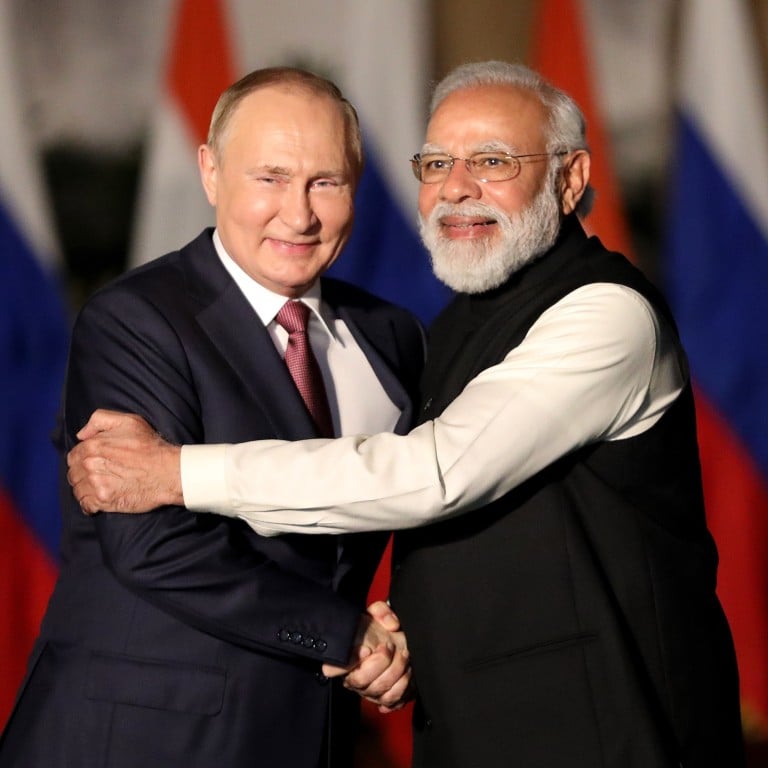
India-Russia ties: why Putin-Modi arms deals are a problem for both China and the United States
- Since the start of the Ukraine crisis, Russia has been getting closer to China. Yet now Moscow is selling India weapons likely to be pointed in Beijing’s direction
- The US, too, will feel aggrieved, as such deals will make it hard for it to ask New Delhi to join in sanctions against Moscow for its actions in the Crimea
Harsha Kakar, a retired major general in the Indian army, said the meeting proved that despite Russia’s close ties with China, and India’s with the West, and “regardless of whatever alignments the countries may be part of, a relationship that has been built up over the years should not be eroded due to geopolitical changes”.
Since the outbreak of the Ukraine crisis in 2014, Russia has strengthened military and economic ties with China in response to the West’s condemnation of its seizure of the Crimea region and backing of a separatist rebellion in the east. The US recently warned Moscow it would face economic sanctions in the event of an attack on Ukraine.
While the Russians expressed concerns over US military activity in the Asia-Pacific region to their Indian counterparts, who pointed to “unprovoked aggression on our northern border” in a reference to China, the bilateral meeting yielded a wide range of agreements.

The two leaders signed 28 deals in areas such as coal, shipbuilding, metallurgy, and oil. Moscow and New Delhi also pledged to raise bilateral trade to US$30 billion and mutual investment to US$50 billion by 2025.
Putin and Modi’s meeting also yielded a contract allowing India to produce more than 600,000 Russian AK-203 assault rifles on its home soil for its armed forces. The two countries also extended a military-technical agreement that helped facilitate the transfer of defence technologies between the two countries for another 10 years.
Russia has sold India approximately US$70 billion worth of weaponry since 1991, according to Russian government statistics, and while sales have dipped due to India’s efforts to produce arms domestically, both countries have worked on joint weapons development projects from supersonic cruise missiles to stealth frigates.
The long-range S-400 air defence system, which India bought from Russia in 2018 and is currently being delivered, perhaps best illustrates the complicated geopolitical dynamic the two countries find themselves in.

Alexey Kupriyanov, a senior research fellow at the Institute of World Economy and International Relations of the Russian Academy of Sciences, argued that from Moscow’s point of view having both India and China armed with the S-400 actually lessened the likelihood of war by helping to even the balance of power between the two countries. At the same time, he said, strengthening defence ties with India was “an opportunity for Russia to continue its pivot to Asia without becoming overly dependent on China”.
“Russia is not interested in becoming a military ally of China or giving up its sovereignty in any way, however in the current situation, the US and Europe are effectively pushing Russia towards such an alliance,” Kupriyanov said.
But China is not the only country that could have a problem with India’s S-400 acquisition. In 2017, the US Congress passed the Countering America’s Adversaries through Sanctions Act (CAATSA), which included a provision calling for sanctions against individuals and entities that engage in a “significant transaction” with the Russian defence sector. So far, customers of the S-400 have been the legislation’s primary target: Washington imposed CAATSA sanctions against China in 2018 and Nato ally Turkey in 2020 for purchasing the Russian air defence system.
A message for US and China as India and Russia put two and two together
However, there is a possibility that India could avoid a similar fate, with members of Congress urging Washington to not impose such sanctions against fellow Quad member states. The US State Department said last month that the Biden administration had not determined whether it would waive sanctions on India’s purchase of the S-400 but Richard Rossow, an expert on US-India relations at the Centre for Strategic and International Studies in Washington, said there was a high chance of this happening.
“It’s going to be a tough go on CAATSA sanction,” he said. “India is going to have to make the case that its importance to the US as a security partner and market for our businesses outweighs [Washington’s] concerns about Russia.”

In the event of a Russian military offensive in Ukraine, Rossow said the US would avoid putting India in an “awkward position” by demanding that it join the West in penalising Moscow. Washington would however, probably push New Delhi to “draw down its relationship with Russia”, especially in the defence realm.
Russia could upset India’s US-China balancing act
But Kakar argued that New Delhi would almost certainly balk at such a request. If the West were to impose new sanctions against Russia, India would most likely look for ways to bypass or manage them rather than cut back ties with Moscow.
“We have always stood by each other through thick and thin,” Kakar said. “No matter what happens with any other third parties, I think Indian-Russian relations will continue to grow. There simply is no way that they can be stalled or move backwards.”

